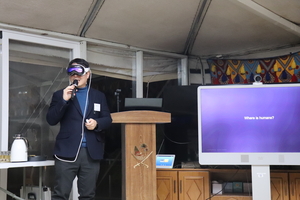Decoding Daily Life: Apple’s LLM Leap into Audio-Motion Intelligence
Apple Inc. has taken a significant step forward in the world of artificial intelligence, particularly in the area of large language models (LLMs). A recent study published by Apple’s machine learning research team reveals groundbreaking methods for utilizing LLMs to interpret audio and motion data, ultimately inferring user activities with unprecedented accuracy. This research, made accessible on Apple’s Machine Learning Research portal, emphasizes the potential for on-device AI to comprehend daily routines without needing cloud-based processing, reinforcing Apple’s commitment to user privacy.
The study builds on Apple’s foundational models introduced earlier this year, utilizing extensive datasets that combine audio clips with motion metrics sourced from devices like the Apple Watch. Researchers have trained LLMs to recognize patterns in activities ranging from exercising and commuting to even subtle actions such as typing. This approach not only focuses on activity recognition but also enhances contextual understanding, enabling the model to analyze sequences of events to predict user states effectively.
Experts in the industry view this as a natural progression for the suite of features known as Apple Intelligence, launched in iOS 18 and subsequent versions. A report from Startup News FYI notes that this research utilizes LLMs to process raw audio and motion streams, achieving a higher accuracy rate than traditional machine learning techniques. AI enthusiasts on X (formerly Twitter), including researchers like Tanishq Mathew Abraham, have praised these multimodal advancements, highlighting how Apple’s 3B-parameter on-device model is optimized for Apple silicon.
The Mechanics of Multimodal Sensing
At the heart of this research lies a sophisticated architecture that integrates audio spectrograms with data from accelerometers and gyroscopes. Apple engineers have refined their foundational models—similar to the MM1 series discussed in previous studies—to treat these inputs as tokenized sequences, akin to text processing. This allows the LLM to effectively “read” a user’s physical environment, identifying behavioral patterns that may signify stress or relaxation based on movement or breathing sounds.
Privacy is a central concern, with all processing designed to occur directly on devices. The research paper underscores the use of differential privacy techniques, ensuring that data collected during training is anonymized. This approach significantly mitigates the risks associated with data breaches, a growing concern given the rising number of cyber threats in the AI domain.
When compared to competitors like Google’s DeepMind, Apple seems to have carved out a competitive edge in efficiency. While Google has delved into cross-modal generation, as reflected in recent patent discussions on X, Apple’s focus on low-latency, on-device inference distinctly sets it apart. A review from AI Connect Network commends the study’s handling of token inefficiency, suggesting potential speed enhancements for LLM tasks up to fivefold.
Implications for Health and Wellness Tracking
Beyond the technical advancements, the implications for health and wellness tracking are particularly intriguing. Imagine an Apple Watch that not only counts steps but can also infer whether you are in a meeting by detecting muffled voices and minimal motion, automatically adjusting notifications accordingly. The study’s findings indicate that LLMs can accurately identify sleep stages by analyzing audio cues such as snoring patterns in conjunction with heart rate variability.
This follows the trajectory of Apple’s previous health initiatives, including the Heart and Movement Study initiated in 2019. By integrating LLM technology, future iterations of devices may be able to predict health events, such as early signs of fatigue or even pregnancy, as hinted in discussions on X by investor Josh Wolfe.
However, there are ethical concerns regarding potential overreach. If LLMs can deduce sensitive information from ambient data, questions surrounding consent and data usage inevitably arise. While Apple advocates for user-controlled opt-ins, industry observers speculate about possible regulatory scrutiny under frameworks like GDPR, as discussed on platforms like 9to5Mac.
Pushing Boundaries in AI Integration
The study’s methodology included training on an extensive dataset, comprising 2.5 billion hours of anonymized data from over 162,000 participants. This scale rivals those of major AI datasets, allowing the LLM to generalize across various environments—from urban commutes to rural hikes—with accuracy rates surpassing 90% in controlled tests.
Integration with the existing Apple ecosystem is seamless. For instance, pairing this technology with Siri could lead to proactive suggestions, such as reminders to hydrate based on detected physical activity. Updates to Apple’s foundational models indicate ongoing refinements, including support for multiple languages to cater to global users.
As competition heats up between companies like OpenAI and Meta, which are pursuing generalized AI, Apple’s focus on sensor-driven intelligence positions it uniquely in the market. News from WebProNews highlights that such optimizations could significantly reduce latency in on-device tasks, making real-time activity inference achievable without excessive battery drain.
In conclusion, Apple’s advancements in audio-motion LLMs signal a transformative shift towards more intuitive, context-aware computing. As the company continues to refine these models, users can expect integrations that make devices feel increasingly like extensions of human intuition while adhering to stringent privacy standards. This recent study serves not merely as research but as a blueprint for the forthcoming era of personal AI.
 Trump Reveals AI-Generated Video with Ronaldo, Sparking Debate on Digital Authenticity
Trump Reveals AI-Generated Video with Ronaldo, Sparking Debate on Digital Authenticity Gaming Exec Claims “Gen Z Loves AI Slop,” Sparking Backlash Over AI in Video Games
Gaming Exec Claims “Gen Z Loves AI Slop,” Sparking Backlash Over AI in Video Games OpenAI Launches GPT-5 with Enhanced Reasoning and Customizable Response Modes
OpenAI Launches GPT-5 with Enhanced Reasoning and Customizable Response Modes Google Launches Gemini 3 Pro, Setting New Standard in AI Performance and Visual Reasoning
Google Launches Gemini 3 Pro, Setting New Standard in AI Performance and Visual Reasoning NVIDIA Unveils Nemotron Elastic LLMs, Reducing Training Costs by 360x with Nested Models
NVIDIA Unveils Nemotron Elastic LLMs, Reducing Training Costs by 360x with Nested Models










































































